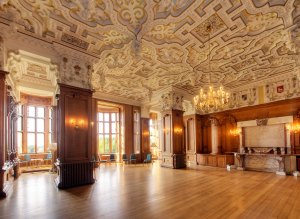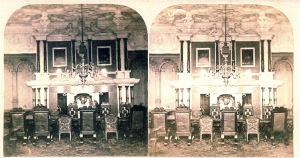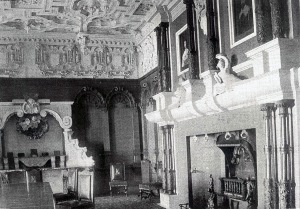The deeply coffered Jacobean ceiling and frieze and the large marble fireplace are all carefully copied from the 1610 period. The ceiling is lavishly decorated with the crowned monograms of Elizabeth I and James I. Daniel De Ligne was made a knight in 1618 by James I, and the ceiling records this piece of Harlaxton heritage by including the Tudor Rose and a motto attributed to Elizabeth I. The Elizabethan-style pendant is combined with Jacobean strapwork on the ceiling.
The frieze features 22 family crests; these were blank until the University of Evansville added the coats of arms of local and American families, patrons, and institutions who have been benefactors and helped with the restoration of the house. There is a key on the wall.
The oak paneling is thought to have been locally sourced from Belvoir Forestry.
The view from the oriel window down the main drive to Bottesford church, over 5 miles away, has been described by Pevsner (1989) as “the finest contrived view in the country”.
The elements for the Italian marble Jacobean-style fireplace and buffet table were bought by Gregory Gregory on one of his European travels. The buffet was originally far more ornate (see earlier photographs below). The stands of the server are upside down to support the top. The fireplace was possibly inspired by Cranborne, Dorset or Gregory’s visit to Hatfield House, in particular the Long Gallery and King James Drawing Room. The twelve black Dinant marble colonnettes were originally part of the jube or choir screen in the Church of Sainte-Waudru at Mons where they were located between 1535 and 1795. Two of the colonnettes have inscriptions on them (second from left, upper and lower)(further information and sketches). There are two Austrian 18th century oval pine reliefs either side of the fireplace depicting St. Boniface with a sword and St. Helena with a cross.
One hidden door in the right corner of the room leads to stairs, now blocked up, which originally were used by servants to bring food up from the kitchens unobserved by guests and family at the dining tables. A further set of doors inside eradicated any food smells and sounds. Another hidden door in the left corner provides access to The Great Hall.
Above the door to the Ante Room putti bear shields carved with the arms of Gregory Gregory’s ancestors; from left (English ancestry) to right (foreign ancestry), Upton, Kyme, Denton, Alton, Gregory (above doorway), Aremberg, de la Marck and de Ligne. The Gregory shield also sits centrally high above the fireplace.
The State Dining Room in previous times
The marble chimney-piece was said to contain no less than seven tons of black, white, and sienna marble. In these old photographs can be seen over the mantel embedded in the marble, the likenesses of Sir Daniel and Lady de Ligne. Over the fireplace there used to be silver handles “for gentlemen to hold by when warming their feet.”
The marble side-board once displayed Mr. Gregory’s enormous silver punch bowl, and a massive silver wine-cooler. There was a dining table with carved legs of walnut, with chairs in red morocco, and an elaborate Spanish chandelier and silver sconces.
From Reminiscences of a visit to Harlaxton Manor House, The Grantham Journal, Saturday May 28, 1859.





